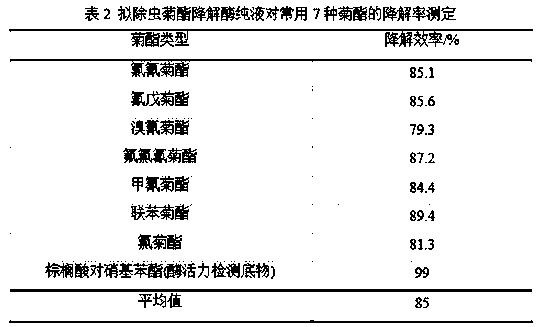Pyrethroid degrading enzyme, coding gene of pyrethroid degrading enzyme and recombination strain and application of coding gene
A technology of pyrethroids and pyrethroids, which is applied in the field of pyrethroid degrading enzymes, can solve the problems of complex preparation process, high risk of E. coli endotoxin, and few types of pyrethroid pesticides, and achieve good fermentation stability, Simple preparation process and obvious degradation effect
- Summary
- Abstract
- Description
- Claims
- Application Information
AI Technical Summary
Problems solved by technology
Method used
Image
Examples
Embodiment 1
[0024] The embodiment of the present invention provides a pyrethroid degrading enzyme coding gene YLL2-C244A, the nucleotide sequence of the coding gene YLL2-C244A is shown in SEQ ID No.1.
[0025] The present invention also provides a recombinant strain YLL2-X33 containing the above-mentioned pyrethroid degrading enzyme coding gene YLL2-C244A; its construction method is as follows: use Pichia pastoris universal signal peptide α-factor as a guide, and use pPICZaA as an expression vector , by screening a series of lipases, the YLL2-C244A mutant secreted expression vector was constructed and transformed into Pichia pastoris X33, and the multi-copy recombinant strain YLL2-X33 was obtained by screening with the antibiotic bleomycin Zeocin. The Pichia strains used in the recombinant Pichia pastoris YLL2-X33 in this example are stable and safe, the fermentation process is simple, the fermentation titer is high, and it can obviously degrade various pyrethroid pesticides.
[0026] The...
Embodiment 2
[0027] Example 2 Preparation method of pyrethroid degrading enzyme enzyme liquid
[0028] Shake flask culture of seeds: get the recombinant strain YLL2-X33 containing the coding gene YLL2-C244A shown in SEQ ID No.1 to activate the recombinant strain YLL2-X33, and continue to use YPD medium to shake the flask at 28°C and 150rpm for 21h ,spare;
[0029] Fermentation culture: Take a fermenter and use BSM medium. The base material formula is dihydrogen phosphate, potassium dihydrogen phosphate, magnesium sulfate, potassium sulfate, calcium sulfate, potassium hydroxide, glycerin, PTM1, biotin, etc., and tap water; 120°C Sterilize for 30 minutes, cool and insert the strain into the shake flask to ferment for 110 hours under the conditions of temperature control 28°C and pH 4.8. Through feeding, controlling the ventilation rate and rotating speed, the dissolved oxygen in the fermenter is always controlled to be greater than 20%; during this period, the velocity of the 2# feed contai...
Embodiment 3
[0032] Example 3 Enzymatic properties of the pyrethroid degrading enzyme
[0033] 1. Enzyme activity of the pyrethroid degrading enzyme
[0034] 1 gram of pyrethroid degrading enzyme powder (or 1 mL of pyrethroid degrading enzyme solution), hydrolyzes p-nitrophenyl palmitate for 1 min in 25 °C, pH7.6 buffer solution to produce 1 umol of p-nitrophenol, which is 1 A unit of enzyme activity expressed in u / g (or u / mL).
[0035]Enzyme activity detection uses a self-built method for measuring the production rate of p-nitrophenyl palmitate (referred to as "pNPP") to p-nitrophenol. The specific method is as follows:
[0036] Prepare a 10mL glass test tube, draw 5900mL 0.05mmol / L pH7.6 Tris-hydrochloric acid buffer solution, 75mL10mmol / L p-nitrophenyl palmitate isopropanol solution, mix well and bathe in a water bath at 25°C for 3min, then add 120uL permethrin Immediately after degrading the enzyme sample water dilution solution, start timing from 0s and mix evenly. Use the blank sam...
PUM
| Property | Measurement | Unit |
|---|---|---|
| Molecular weight | aaaaa | aaaaa |
Abstract
Description
Claims
Application Information
 Login to View More
Login to View More - R&D Engineer
- R&D Manager
- IP Professional
- Industry Leading Data Capabilities
- Powerful AI technology
- Patent DNA Extraction
Browse by: Latest US Patents, China's latest patents, Technical Efficacy Thesaurus, Application Domain, Technology Topic, Popular Technical Reports.
© 2024 PatSnap. All rights reserved.Legal|Privacy policy|Modern Slavery Act Transparency Statement|Sitemap|About US| Contact US: help@patsnap.com










